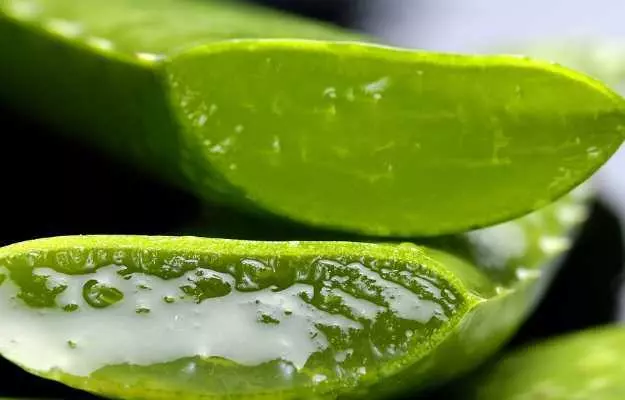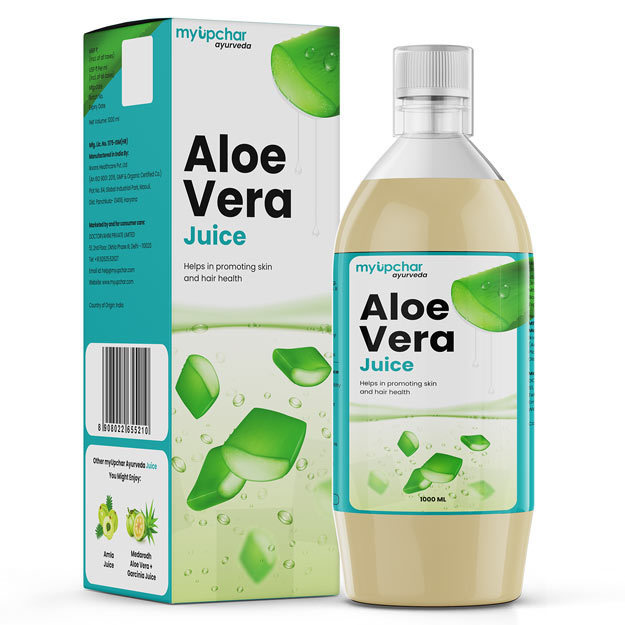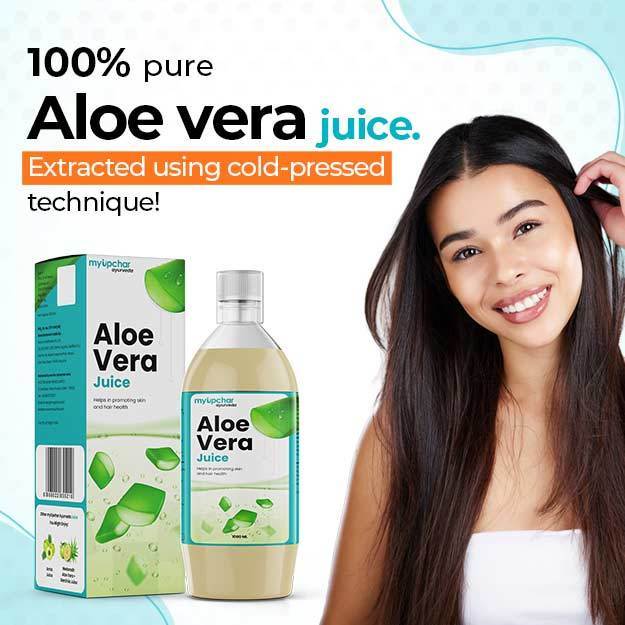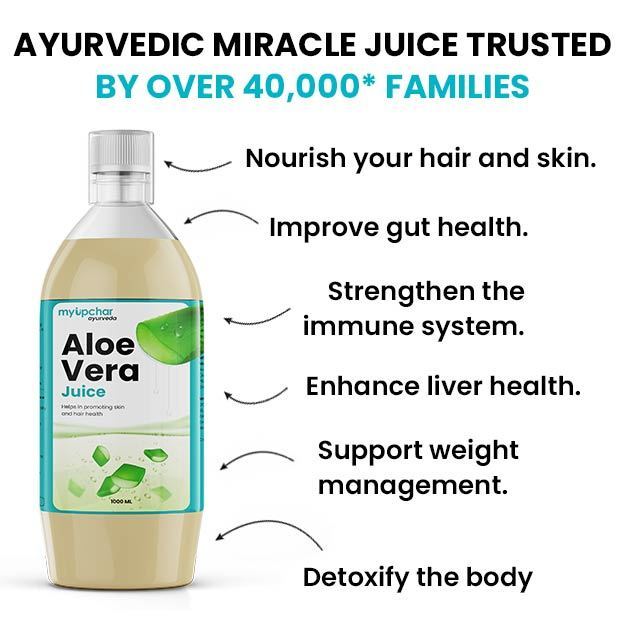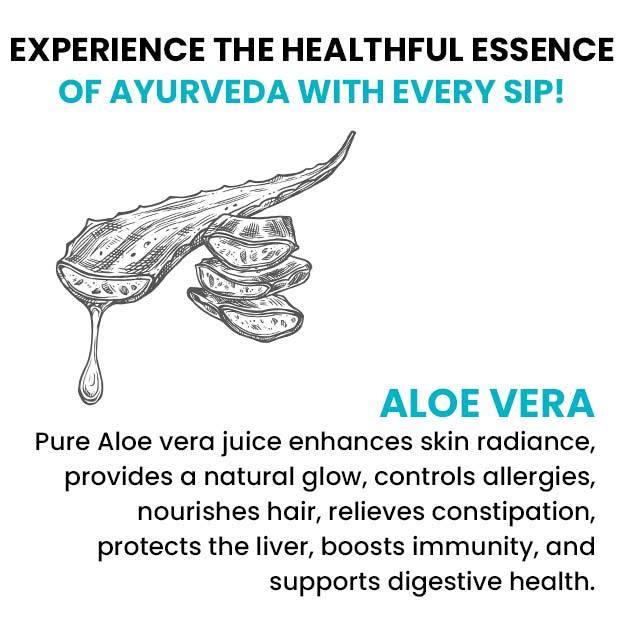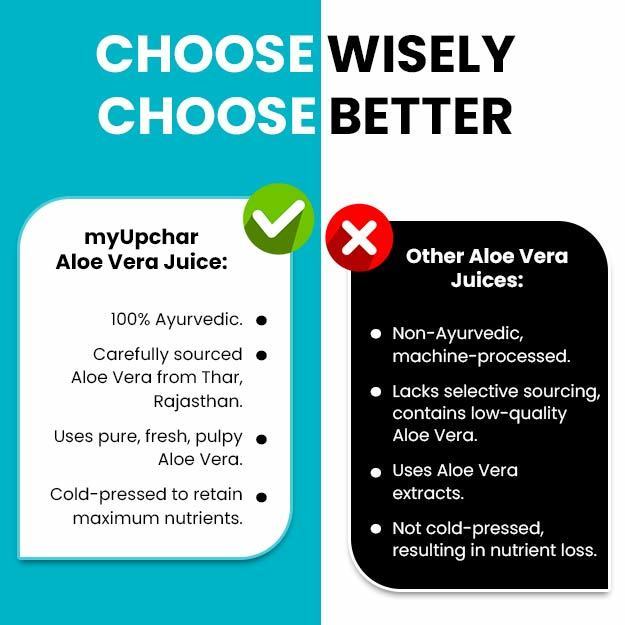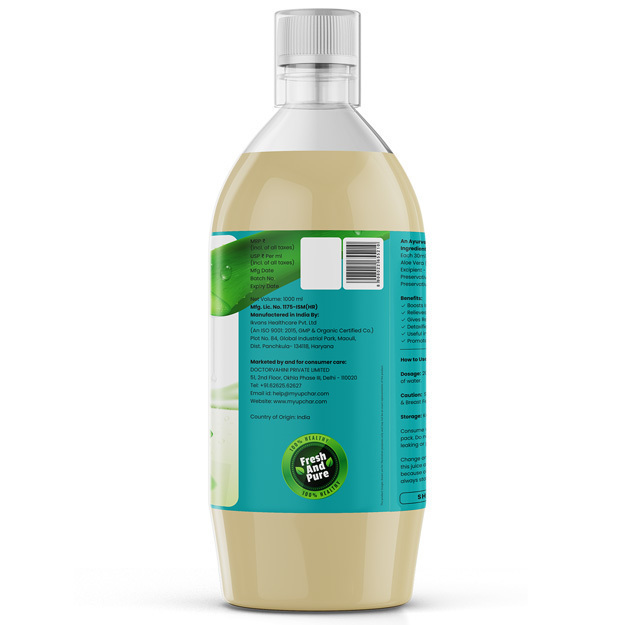Aloe vera as you may already know has risen from the pages of “Rigveda” with great potential.
It has found its way into every household across the world because, its a superfood, for many a beauty secret, and “Mystery Plant”. In fact, it is also famously known as ghritkumari in India. According to ayurvedic researchers, its called “kumari” in Sanskrit because of its strikingly helpful properties for regulating the menstrual cycles in females and also the plant never seems to grow old hinting the gift of flawless skin. Whether its ayurveda or the western medicine, every traditional system of medicine has a special place for this herb.
Aloe vera is a succulent plant (tender, juicy). Its thick fleshy leaves and stem are used mainly for storing water. In ayurveda , aloe vera is specially mentioned for its beneficial effects on the gut and liver. According to the famous naturalist and author Pliny the Elder, aloe vera can be used to treat leprosy sores. This herb was not only popular in the Indian subcontinent, Scholars found a detailed description of this plant in ancient Egyptian documents. In fact, it is said that the Egyptians called it the “Plant of immortality”. The famous Egyptian queen Cleopatra is believed to have used it in her beauty regime!
Did you know?
The name aloe vera comes from the Arabic word “Alloeh” which means “shining bitter substance” and “vera” is a Latin word which means “true”.
Some basic facts about Aloe vera:
- Botanical name: Aloe barbadensis miller
- Family: Asphodelaceae (Liliaceae)
- Common name: Aloe vera, Burn plant, Ghee Kumari, Kumari.
- Sanskrit name: Ghritkumari
- Parts used: Leaves
- Native region and geographical distribution: Aloe vera is a native of Africa but over the course of time it has escaped its native land and found its way to most of the drier regions of the world including the Middle East and India. In India, it is found in Rajasthan, Andhra Pradesh, Tamil Nadu, Maharashtra, and Gujarat.
- Energetics: Cooling
- Health benefits of Aloe Vera
- Aloe vera plant and how it is used
- Aloe vera dosage
- Side effects of aloe vera
Health benefits of Aloe Vera
Aloe vera is most commonly used for burns and skin problems. As some of you may already know that aloe vera is like a “small wonder” of possibilities. Let’s explore some of the uses and actions of aloe vera.
- Delays ageing: Aloe gel is widely used in anti-ageing skin creams and lotions. It moisturises your skin and promotes skin regeneration, reducing the first signs of ageing such as wrinkles and fine lines.
- Promotes wound healing: Aloe vera is the best remedy for all kinds of wounds. In a series of studies, it is indicated to be effective in promoting skin repair and healing in cuts, burns, sunburns and radiation burns.
- Relieves stomach problems: Aloe gel and latex are claimed to be useful in improving gastrointestinal conditions like GERD, inflammatory bowel disease and constipation. However, unsupervised consumption may cause diarrhoea.
- Good for oral health: Aloe gel promotes oral health by killing plaque-causing bacteria and preventing gingivitis. Aloe gel application has also been demonstrated to be useful against mouth ulcers while posing no threat to your health.
- Natural antioxidant and antibacterial: Aloe vera, alleviates free radical damage and damage caused by bacterial infection. This is helpful in keeping you healthy and promoting organ function along with delaying ageing process.
- Reduces blood sugar levels: Aloe gel is extensively studied for being a hypoglycemic agent (reduces blood sugar) and most studies confirm its efficiency in diabetes. Final-phase studies are currently going on to determine dosage and safety for therapeutic use.
- Provides longer and shinier hair: Aloe vera hydrates and nourishes your scalp. It helps condition your hair and balances scalp pH. Together all of these properties promote hair growth and slow down hair greying.
- Lowers cholesterol: Research published in the Journal of Nutritional Science and Vitaminology suggests that aloe gel reduces cholesterol production in liver by 30%. This reduces the risk of plaque formation and atherosclerosis.
- Reduces cancer risk: Aloe vera is rich in antioxidants like vitamins and zinc, which are suggested to slow down the growth of cancerous cells. It also prevents tumour formation. Though studies are still underway to understand the anti-cancer activity of this herb.
Aloe vera gel benefits for skin
There are a lot of aloe vera creams and anti-ageing lotions available in the market for a variety of skin types. But, you are highly recommended to check how natural and genuine they are. If you are looking for an easy and trusted remedy for a healthy skin then it’s preferable to use aloe vera gel in its natural form. Natural aloe vera gel comes with all the benefits of those costly creams and it has almost no side effects.
Studies show that adding aloe vera in your diet has a significant effect in reducing stretch marks and other premature signs of ageing. When it is used topically, aloe vera has a natural moisturizing and stimulating effect on the skin. Aloe vera primarily hydrates your skin, and a hydrated skin is a healthy skin which glows and is desired by everyone. Regular use of aloe vera helps keep the skin hydrated and makes the skin cells to grow and connect faster, thus improving the elasticity of the skin.
Read more: How to get clear skin fast
Apart from the anti-ageing activities, aloe vera gel has a lot of benefits for your skin.
- Fast wound healing: Aloe vera is considered one of the best herb for wound healing in folk remedies. Extensive research has been done globally to understand the mechanism behind this property and it has been found that the gel has some components (a growth hormone), which connects with the fibroblasts (skin cells that help in regenerating new skin and healing injury) and thus help the skin cells to grow around the injury. The healing properties have been found to be equally beneficial in both oral and topical administration.
- Effective in healing burns: Aloe vera gel is prescribed by Ayurvedic doctors for treating first and second-degree burns. The gel is generally applied directly on the affected area. A study claims that aloe vera is more effective in healing burn wounds than vaseline gauze. The study also stated that the average time for wound healing by aloe vera was found to be approx 12 days while it took around 18-20 days for the vaseline gauze to do the same.
- Remedy for sunburn: Aloe vera is probably the first home remedy that comes to mind when one wants to get relief from a sunburn. Apart from its already mentioned skin healing benefits, a topical application of aloe gel has a soothing effect on the sunburnt skin with almost no side effects. So next time you get a red patch of skin from being under the sun rub some aloe gel to get instant relief. Read more: Home remedies for sunburn
- Reduces the side effects of radiation: Patient survey-based evidence says that aloe vera can be effectively used for treating radiation burns in chemotherapy patients. Further research claims that aloe gels are more effective and faster in treating burns than aloe-based creams.
Aloe vera for stomach infections and constipation
How frequently are you facing stomach problems? Do you suffer from heartburns also? These could be the symptoms of an infection causing inflamed stomach or GERD (Gastroesophageal reflux disease). A recent study suggested that aloe vera may be helpful for the management of inflammatory bowel disease (IBS). Additionally, It is suggested to consume aloe latex to treat constipation because it is a very good laxative. However, please check with your doctor before consuming aloe vera in the form of juice or latex because there have been reported cases of diarrhoea after more than the required consumption of aloe juice.
Read more: Digestive disorders causes
Aloe vera for healthy gums and teeth
We all desire to have healthy gums and strong teeth as good oral health is as important as healthy and glowing skin. With the increasing number of antibiotic-resistant diseases, there is a need for a natural alternative for maintaining good oral hygiene.
Read more: What is antibiotic resistance
Recent advancements in ayurveda claim that aloe vera gel is very effective in reducing dental plaques and gingivitis without having any side effects. It does so by killing the bacteria that are responsible for these oral problems. Additionally, evidence has also been found that the application of aloe gel helps heal mouth ulcers fast and effectively.
Aloe vera as an antioxidant and antibacterial
A recent research shows that aloe vera has antioxidant and antibacterial properties which help fight bacterial infections of the skin. Traditionally, it is used in the treatment of acne, dandruff, and other common bacterial skin infections. However, more research is still needed in this field. So, it’s suggested to consult your ayurveda doctor before using aloe vera for any kind of skin condition.
The study further suggested that the phytochemical composition of aloe vera is helpful in dealing with or reducing the symptoms of heart diseases, diabetes, and neurodegenerative diseases.
Read more: Bacterial infections symptoms
Aloe vera for diabetes
Extensive research has been done on the antidiabetic properties of aloe vera gel and in three different studies and it was found that consumption of aloe vera juice has a significant effect in reducing the blood sugar levels in diabetic patients. However, studies are in final trial phases to test its safety and dosage for a regular and effective treatment.
Read more: Diabetes treatment
Aloe vera benefits for hair
The moisturizing effects of aloe vera not only benefit the skin but they extend to the scalp and hairs too. When used as a conditioner it helps maintain hair health and balance the pH of the scalp thus avoiding hair fall and making the hair lustrous. Research says that aloe vera gel is a good source of vitamins and enzymes which helps nourish the hair follicles and leads to a faster hair growth.
Read more: How to make your hair grow faster
Aloe vera as an anti-tumor agent
In a group of researches carried out to test the anti-tumorigenic properties of aloe gel and extract, both oral and topical preparations were found to be effective in delaying the growth of tumorigenic cells. In one of these studies, this chemoprotective property of the aloe vera plant is attributed to its antioxidative agents, like vitamins and enzymes and some minerals like selenium and zinc. Studies are still in progress to find a more effective way of developing this plant as an effective antitumor medicine and making it available as a cheaper alternative for cancer treatment.
Read more: Difference between cancer and tumour
Aloe vera for lowering cholesterol
Extensive research was conducted on aloe vera gel shows that it reduces the “bad” or low-density cholesterol (LDL) from the body and increases the “good” or high-density cholesterol (HDL) in the body. Removal of bad cholesterol leads to a lesser risk of diseases like atherosclerosis (fat deposits in arteries) thus promoting a healthier heart. Additionally, lower level of LDL cholesterol makes the body to lose weight more easily.
A research published in the Journal of Nutritional Science and Vitaminology also indicated that consumption of aloe vera reduces the cholesterol production of the liver by 25-30 percent.
Read more: High cholesterol treatment
Aloe vera plant and how it is used
Aloe vera has a wide range of uses but most importantly it is used for its skin and gut benefits.
There are two major things that are obtained from aloe vera:
- Gel: A clear and odorless substance which is obtained from the inner part of the leaf.
- Latex or juice: A yellow substance obtained from the outer part of the leaf.
The latex is used as a laxative(to ease bowel movement), so a regular consumption is not suggested, but the gel can be consumed more frequently and it is this part of the leaf that has most of the skin and health benefits.
The gel can be obtained directly from the plant by making an incision in the leaf. However, it is not advisable to consume the raw latex or complete leaf of the plant as it might be potentially harmful to the body.
Aloe vera gel and juice are also available in pasteurized forms in the market (If you are looking for a pasteurized gel in the market, it is advisable to check the label for the word “flash pasteurized” as this kind of pasteurization sterilizes the gel without affecting its medicinal benefits)
Apart from its direct use as gel and juice, it has found its way into the beverage and cosmetic industry too. The commercial industry uses it in the form of milk, tea, creams, confectionary, powder (used to make ice creams, yoghurt, and lassi), face wash, lotions and other skin products. Soft gel capsules of aloe vera are also readily available in the market for consumption and skin uses.
Did you know that aloe vera is a very good air purifier? According to a study by NASA, it’s one of the plants which help in keeping the air clean and providing more oxygen in its vicinity.
Growing aloe vera plant at home
Aloe vera is a hardy plant (can survive harsh climate) and grows both indoors and outdoors (indoor plants growing slower than the outdoor plants) without much care as long as it is provided with proper drainage. It can grow in tropical and subtropical areas between the temperature range of 12-27 degree centigrades.
If you are living in a colder area, its best to keep it under the sun during the day and bring it indoors in the evening.
Aloe vera can be grown by leaf cuttings or by offshoots (small plants which grow themselves from the parent plant). However, gardeners suggest that it's better to grow it from the offshoots as leaf cuttings are a bit tricky to use and grow.
Planting:
- Clear a small amount of soil from the base of the offshoot to check where the roots are.
- With a clean knife, separate the tiny plant from the main plant, making sure that it contains roots.
- Pot this new plant into a new pot with well-drained soil.
Drainage is essential for aloe plant, and even though it's easy to grow and maintain, lack of proper drainage could kill the plant.
How to make aloe vera gel at home?
The best part is, aloe gel can be easily made at home without much trouble. To obtain your own aloe gel, cut a leaf from the aloe plant and put them in a bowl with the cut end at the bottom. The leaf would start seeping its yellow liquid. Wash the leaf after it stops draining. Make a cut in the leaf with a knife and peel off the outer skin. Once this layer is peeled you will be left with a clear, transparent gel. You can either use it right away or preserve it in the freezer for future use. The gel lasts up to a week in the freezer.
Aloe vera dosage
Aloe gel can be applied topically without much side effects (apart from people who are naturally allergic to the plant). Dosage and amount of skin creams, lotions, beverages etc would depend on the amount of aloe vera present in the product.
Ideally, one ounce or two tablespoons of aloe juice daily on an empty stomach is considered safe. But several factors like age, gender and symptoms may have an effect on the dosage. So, before adding aloe vera to your diet or skincare routine, it's advisable to refer to a registered ayurvedic practitioner.
Side effects of aloe vera
- Regular consumption of aloe latex is known to cause gastrointestinal problems.
- Some people are extra sensitive to aloe vera so its best to check with your doctor before consuming aloe vera in any form.
- Aloe gel should not be given orally to children below 12 years of age as it may cause stomach discomfort and diarrhoea.
- It is not considered safe for pregnant women because there have been few reported incidences of miscarriages and birth defects.
- Applying aloe vera right before going out in the sun might cause sunburns.
- If you are already on some prescribed medicines, refer to a registered medical practitioner before adding aloe vera in your diet as it can interfere with the effects of the medicine.
(Get online doctor consultation for any health issue)
Medicines / Products that contain Aloe vera
- Medarodh Garcinia Juice By Myupchar Ayurveda - ₹485
- Kesh Art Bhringraj Hair Oil for Controlling Hair Fall & Dandruff, Grow Hair 2X Fast - ₹546
- Myupchar Ayurveda Kumariasava 450ml - ₹379
- Aloe Vera Juice By Myupchar Ayurveda - ₹242
- myUpchar Ayurveda Kesh Art Hair Cleanser - ₹329
- Alograce Soap - ₹152
- Elovera Imf Cream - ₹266
- Dhootapapeshwar Kumari Aasav No 1 - ₹204
- Baidyanath Pradarantak Ras - ₹174
- Ayur Herbal All Purpose Cream with aloe vera - ₹152
- Baidyanath Lauh Bhasma 5gm - ₹48
- Aimil Purodil Tablet - ₹185
- Elovera Lotion 75ml - ₹218
- Himalaya Nourishing Skin Cream 100ml - ₹118
- Himalaya Anti Wrinkle Cream - ₹256
- Rejuglow Face Wash - ₹318
- Baidyanath Godanti Bhasma - ₹82
- Elovera Body Wash Lotion 300ml - ₹630
- Dermadew Aloe Cream 50gm - ₹180
- Baidyanath Vanga Bhasma 10gm - ₹153
- Baidyanath Vanga Bhasma 5gm - ₹93
- Sri Sri Ayurveda Quick Heal Cream - ₹90
- Baidyanath Akik Bhasma - ₹102
- Aimil Amlycure DS Capsule (20) - ₹178
- Baidyanath Harital(Godanti)Bhasma - ₹82
- Dindayal Aushadhi Apple Cider Plus Vinegar - ₹225
- Moha Foot Care Cream 100gm - ₹251
- Dermadew Aloe Cream 150gm - ₹399
- Dermadew Aloe Lotion 50ml - ₹180
- Acnelak 4in1 Pimple Clear Face Wash - ₹330
- Elovera Cream 500gm - ₹950
- Baidyanath Prawal Bhasma - ₹445
- Planet Ayurveda Gleaming Skin Hair Nail Formula Capsule - ₹1450
- Glogeous Advanced Face Wash Gel - ₹945
- Patanjali Aloe Vera Juice With Fiber - ₹200
- Himalaya Baby Lotion 200ml - ₹185
- Ahaglow Advanced Face Wash 200gm - ₹708
- Himalaya Extra Moisturizing Baby Soap 100gm - ₹52
- Acnelak Soap - ₹123
- Moha Moisturizing Lotion 200ml - ₹267
- Himalaya Aloe & Cucumber Refreshing Body Lotion 200ml - ₹180
- Baidyanath Rajahprawartini Vati (80) - ₹179
- Ahaglow Acne Control Moisturizing Gel - ₹572
- Baidyanath Mandoor Bhasma - ₹79
- Calapure A Lotion 100ml - ₹189
- Himalaya Clarina Anti Acne Kit - ₹242
- Allsuth Lotion - ₹243
- Himalaya Gentle Baby Wipes (72) - ₹190
- Moha Herbal Shampoo 100ml - ₹181
- Amyron Capsule - ₹185
References
- Amar Surjushe, Resham Vasani, and D G Saple. ALOE VERA: A SHORT REVIEW. Indian J Dermatol. 2008; 53(4): 163–166. PMID: 19882025
- Kulveer Singh Ahlawat and Bhupender Singh Khatkar. Processing, food applications and safety of aloe vera products: a review. J Food Sci Technol. 2011 Oct; 48(5): 525–533. PMID: 23572784
- Visuthikosol V et al. Effect of aloe vera gel to healing of burn wound a clinical and histologic study.. J Med Assoc Thai. 1995 Aug;78(8):403-9. PMID: 7561562
- Vinay K. Gupta, Seema Malhotra. Pharmacological attribute of Aloe vera: Revalidation through experimental and clinical studies. Ayu. 2012 Apr-Jun; 33(2): 193–196. PMID: 23559789
- Langmead L1, Makins RJ, Rampton DS. Anti-inflammatory effects of aloe vera gel in human colorectal mucosa in vitro. Aliment Pharmacol Ther. 2004 Mar 1;19(5):521-7. PMID: 14987320
- Soyun Cho et al. Dietary Aloe Vera Supplementation Improves Facial Wrinkles and Elasticity and It Increases the Type I Procollagen Gene Expression in Human Skin in vivo. Ann Dermatol. 2009 Feb; 21(1): 6–11. PMID: 20548848
- Fatemeh Nejatzadeh-Barandozi. Antibacterial activities and antioxidant capacity of Aloe vera. Org Med Chem Lett. 2013; 3: 5. PMID: 23870710
- Rajendra Kumar Gupta et al. Preliminary Antiplaque Efficacy of Aloe Vera Mouthwash on 4 Day Plaque Re-Growth Model: Randomized Control Trial. Ethiop J Health Sci. 2014 Apr; 24(2): 139–144. PMID: 24795515
- G Sujatha, G Senthil Kumar, J Muruganandan, T Srinivasa Prasad. Aloe Vera in Dentistry. J Clin Diagn Res. 2014 Oct; 8(10): ZI01–ZI02. PMID: 25478478
- Neda Babaee, Ebrahim Zabihi, Saman Mohseni, Ali Akbar Moghadamnia. Evaluation of the therapeutic effects of Aloe vera gel on minor recurrent aphthous stomatitis. Dent Res J (Isfahan). 2012 Jul-Aug; 9(4): 381–385. PMID: 23162576
- Yongchaiyudha S1, Rungpitarangsi V, Bunyapraphatsara N, Chokechaijaroenporn O. Antidiabetic activity of Aloe vera L. juice. I. Clinical trial in new cases of diabetes mellitus.. Phytomedicine. 1996 Nov;3(3):241-3. PMID: 23195077
- Ghannam N, Kingston M, Al-Meshaal IA, Tariq M, Parman NS, Woodhouse N. The antidiabetic activity of aloes: preliminary clinical and experimental observations.. Horm Res. 1986;24(4):288-94. PMID: 3096865
- El-Shemy HA1, Aboul-Soud MA, Nassr-Allah AA, Aboul-Enein KM, Kabash A, Yagi A. Antitumor properties and modulation of antioxidant enzymes' activity by Aloe vera leaf active principles isolated via supercritical carbon dioxide extraction. Curr Med Chem. 2010;17(2):129-38. PMID: 19941474
- Saini M1, Goyal PK, Chaudhary G. Anti-tumor activity of Aloe vera against DMBA/croton oil-induced skin papillomagenesis in Swiss albino mice.. J Environ Pathol Toxicol Oncol. 2010;29(2):127-35. PMID: 20932247

